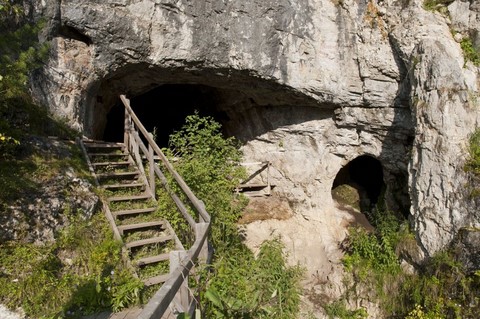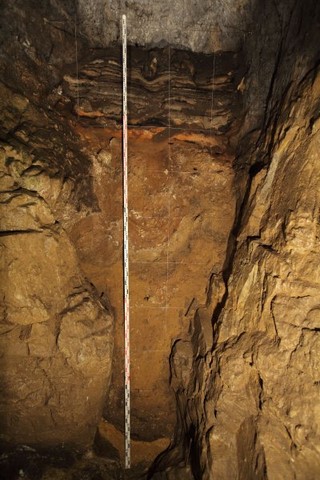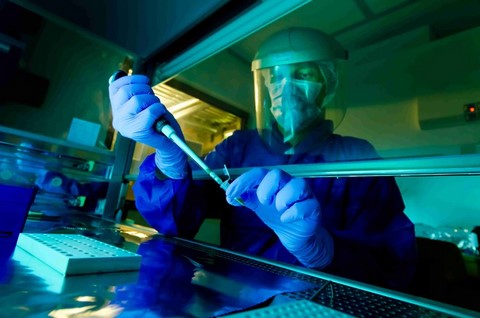Attractive others - the Neanderthal-Denisova girl

A small bone fragment discovered in 2012 in the Denisova Cave, in Southern Siberia, by Russian archaeologists tells a love story. New genetic analyses show that the modestly named "Denisova 11" piece of the catalog stems from a girl whose mother was a Neanderthal and whose father was a Denisova-man, as revealed by articles published in the magazine Nature by an international research-team led by the Max-Planck-Institute for Evolutionary Anthropologie (MPI-EVA) in Leipzig, Germany.
Research has shown, among other things, that these two groups of early humans had common offsprings much more frequently than had been hitherto assumed. “Maybe that Neanderthals and Denisovans did not have many occasions to meet. But when they did, they must have relatively frequently had children together – much more frequently than we had thought up to now,” according to the leader of the study, Svante Pääbo.
Until ca 40,000 years ago, both Neanderthals and Denisovans lived in Eurasia. The Neanderthals settled mostly in the Western part, the Denisovans in the Eastern. Remains of the latter have been found up to now only in the Denisova cave in the Russian Altai mountains, where traces of Neanderthals have also been found.
The bone fragment which was analyzed by the team assembled around Pääbo, the director of the Department for Evolutionary Genetics at MPI-EVA, measures a mere two centimeters. The researchers are dating it back to about 50,000 years ago. Analyses have determined that it stems from a girl who was at least 13 years old at the time of her death. Some small samples of the bone were ground into a powder from which the scientists isolated the genetic material, which was then sequenced.
Comparing the results with already known genetic sequences of a Neanderthal and a Denisovan, the researchers discovered that the girl was a direct offspring of a mixed couple - it carried genetic material of both, in a ratio such as one would expect from a daughter of the couple.
That both hominid groups had offspring together has been known in principle from earlier studies. “But I would never have expected that we would have that much luck, as to hit upon a direct offspring of both groups,” says main author Viviane Slon from Pääbos workteam.


Further analyses showed that the Denisovan father himself carried a small amount of genetic material from Neanderthals. Presumably, more than one Neanderthal ancestor may have figured in his genealogical tree, who may have lived some 300 to 600 generations before him, the researchers are telling us. These Neanderthals belonged to a different group than the one from which the girl’s mother originated.
The girl was genetically more closely related to Neanderthals living in Western Europe than with one Neanderthal who had lived at an earlier point in time in the Denisova cave. This shows that, before they disappeared, the Neanderthals were moving between West- and East Eurasia.
That one should have been able to find a hybrid child among the very few early humans whose genetic material has been deciphered is an indication that such a hybridisation was not a rare event.
But why then did the two groups remain genetically distinct nevertheless? The researchers explains this by the fact that the zone of overlap was for both groups spacially and chronologically confined. It is also possible that the offsprings may have proved to be less resistant than the offspring of “purely” Neanderthal or Denisova couples.
When modern human finally spread over Eurasia, he too must have mixed with his relative, but over a longer period of time and over a wider space.
Anja Garms
Translated from the German by Anne-Marie de Grazia
Go to the original article in Der Spiegel (Aug. 23, 2018)
The Neanderthal in us comes from the females
Up to 2017, nobody had paid attention to the fact that, if modern Europeans harbor 2.5 to 4 percent of Neanderthal genes, none at all come from the Y-chromosome, which men transmit only to their male offsprings and which make the difference between male and female. Intimate liaisons between Neanderthal and modern humans produced offsprings, but only of the female sex.
In principle, one might conjecture that traces of DNA from the Y-chromosome were at one time present in the genome, but that theymy haven gotten lost over time because the carriers of the genetical material did not reproduce. Another possibility could be that female Neanderthal DNA was compatible with ours, but not male DNA.
The researchers' thesis goes like this: when the male Neanderthal genome included something that would have made it incompatible with our own, the consequences could have been that pregnancies with male foetuses did no go normally. So that modern human females could have had daughters from these mixed relationships, but no sons.
The team around Fernando Mendez from Stanford University found indications of precisely this. They discovered differences in the genes of modern human and Neanderthal Y chromosomes in the so-called histocompatibility complex, which means gene which encode cells of the immune system so that the latter can differentiate between tissues of the same body and foreign tissue.
This is well-known from the domain of organ transpants: when the immune system recognizes a transplant as foreign it begins to defend itself against it and to reject it. It is possible that the immune system of Homo sapiens women reacted in the same way against foetuses which carried the Neanderthal Y-chromosome. So that liaisons between modern humans and Neanderthals could only have been successfully fertile when a girl was conceived. Male foetuses in the contrary would have quasily initiated a process of autodestruction and the sapiens female would have quickly lost her child.
This is only a hypothesis so far, but a few arguments speak in its favor: it explains the strange absence of male Neanderthal genetic material in our genome. Moreover, it is known to happen in pregnancies of our own species that male foetuses are rejected when incompatibilities occur in the immune system.
Between two distinct species such incompatibilities come as no surprise, they are even to be expected. Modern man and Neanderthals shared a common origin, but at the time of their meeting their genomes had already considerably separated. Species which are distinct and which have separated sufficiently during evolution cannot produce offspring together. Species which are closely related can produce hybrids, which themselves are infertile. An example of this being the mule – a cross between a horse and a jackass.
Modern human and Neanderthals were obviously still close enough to be able to produce fertile offspring together, yet separated enough for this to not be able to happen without limitations and complications. The discovery of the genetic incompatibility gives us information about how far our relatedness went and possibly also about when the process of our separation actually occured: it had been surmised that Homo sapiens and Neanderthals had started to separate at some point of a time span covering 400,000 to 800,000 years; Considering the male Y chromosome, this time span can be delimited with much greater accuracy: according to Mendez and his co-authors, our last common ancestor whose Y-chomosome would not have exhibited any redhibitory difference was alive some 500,000 years ago.

